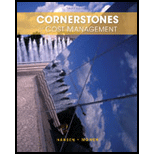
1.
Calculate the velocity and theoretical cycle time that takes to produce one model
1.
Explanation of Solution
Cycle time: Cycle time and velocity are two operational “measures of responsiveness”. Cycle time is the span of time taken to produce a unit of output from the time the materials are received till the good is supplied to finished goods inventory. Therefore, cycle time is the time taken to produce a product.
Velocity: Velocity is the number of units of output that can be produced within a given period of time.
Calculate the theoretical velocity:
Calculate theoretical cycle time:
2.
Calculate the actual velocity and the actual cycle time.
2.
Explanation of Solution
Calculate the actual velocity:
Calculate actual cycle time:
3.
Calculate the manufacturing efficiency cycle and comment on the efficiency of the operation.
3.
Explanation of Solution
Manufacturing efficiency ratio: Manufacturing efficiency ratio is a measure of Just-In-Time (JIT) manufacturing system and it expresses the time spent in value-added activities as a percentage of total cycle time.
Calculate Manufacturing cycle efficiency:
Therefore, from the above calculation, it is noted that, the “efficiency of the operation” is very high.
4.
Compute the budgeted conversion cost per minute, compute the conversion cost per model, compute the conversion cost per model for actual output and explain whether the product costing approach provide an incentive for the cell manager to reduce cycle time.
4.
Explanation of Solution
Calculate budgeted conversion cost:
Calculate theoretical conversion cost per model:
Calculate actual conversion cost per model:
Yes, the cost per unit can be decreased by decreasing cycle time. The potential reduction is $48 (1) per model.
Working note:
(1)Calculate the potential reduction:
Want to see more full solutions like this?
Chapter 13 Solutions
Cornerstones of Cost Management (Cornerstones Series)
 Cornerstones of Cost Management (Cornerstones Ser...AccountingISBN:9781305970663Author:Don R. Hansen, Maryanne M. MowenPublisher:Cengage Learning
Cornerstones of Cost Management (Cornerstones Ser...AccountingISBN:9781305970663Author:Don R. Hansen, Maryanne M. MowenPublisher:Cengage Learning Managerial Accounting: The Cornerstone of Busines...AccountingISBN:9781337115773Author:Maryanne M. Mowen, Don R. Hansen, Dan L. HeitgerPublisher:Cengage Learning
Managerial Accounting: The Cornerstone of Busines...AccountingISBN:9781337115773Author:Maryanne M. Mowen, Don R. Hansen, Dan L. HeitgerPublisher:Cengage Learning

